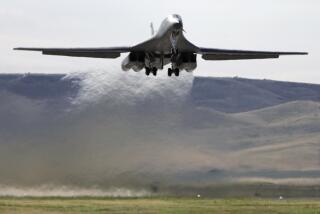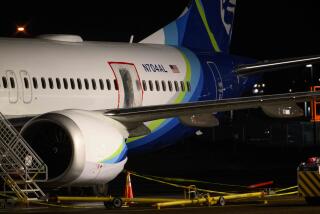2 Crashes of 737s Prompt New Instructions for Pilots
WASHINGTON — With investigators still puzzling over two Boeing 737 crashes, the government ordered pilots who fly the jetliner to get new instructions on how to handle unexplained rudder swings.
Rudder problems are suspected, but not proved, in deadly crashes involving 737s near Pittsburgh in 1994 and Colorado Springs, Colo., in 1991.
The Federal Aviation Administration issued an airworthiness directive Thursday, stipulating that airline flight manuals include procedures for pilots to control a plane that goes into an uncommanded turn or roll. The procedures, recommended by the National Transportation Safety Board, tell pilots how to correct jammed or restricted flight controls.
The FAA said tests conducted by Boeing Co. found the 737’s rudder power control unit could jam in unusual conditions.
In November the FAA ordered tests for all 737s after a rudder-control valve jammed in a laboratory experiment under extreme conditions.
The tests have been completed, and problems were not found, the FAA said Thursday. But it nevertheless decided to order the pilot training as a precaution.
The 737 is the most widely used civil airliner in the world, with 2,705 of the jets flying, including 1,115 in the United States.
Changes in procedures and pilot training must be effected within 30 days, the FAA said, and the total cost to U.S. carriers should be no more than $67,000.
In the Pittsburgh and Colorado Springs crashes, the planes suddenly plunged without their pilots having reported any malfunctions. The Pennsylvania crash killed all 132 aboard, and 25 died in the Colorado accident.
Thursday’s airworthiness directive requires operators of the planes to adopt procedures enabling flight crews to maintain control in unplanned turns and rolls and when flight controls are jammed or restricted.
Both conditions are considered to be remote possibilities, the FAA stressed.
The new order requires a pilot who encounters an unplanned roll to reduce the flight angle immediately by lowering the plane’s nose and to increase speed until control is recovered. In this situation pilots are not required to maintain altitude and must disconnect the autopilot and auto throttle.
In what the agency called the rare possibility of a jammed or restricted rudder, or sharp rudder movement known as a hardover, new instructions tell pilots to disengage the autopilot and auto throttle and use maximum manual force to overpower the rudder system.
If the situation continues, pilots are required to switch to a standby rudder position that includes turning off the aircraft hydraulic system to enable the pilots to perform manual approaches and landings.
More to Read
Inside the business of entertainment
The Wide Shot brings you news, analysis and insights on everything from streaming wars to production — and what it all means for the future.
You may occasionally receive promotional content from the Los Angeles Times.










